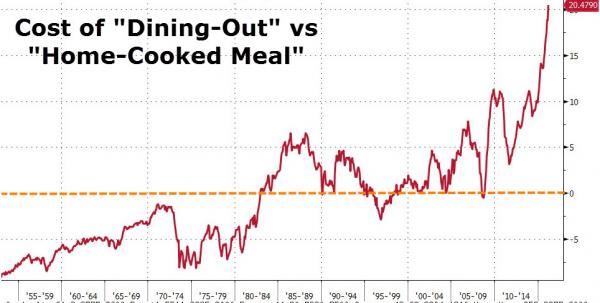30 years ago, dining out for the average American family was a once a week experience, with working parents adding to this total with an occasional lunch break at a restaurant. However, the past three decades have seen this paradigm completely turn around, and in 2015, people spent more money eating out than they did in buying groceries since the convenience of cost was worth the experience.
Yet this trend may have quickly reached a peak here in 2016 as the growing movement of mandatory $15 per hour minimum wage demands being coupled with huge jumps in price inflation have seen the affordability of dining out now much greater than the cost of eating at home.
According to the latest Consumer Price Index data from The Labor Department, it has never - ever - been more expensive to “dine out” relative to “eating at home.”
In December last year, in another instance showcasing the real intellectual capacity of career and academic economists and those clueless enough to listen to them, we warned repeatedly that even the smallest of mandatory wage hikes would ripple through the economy and unleash extensive price increases across the board, not to mention countless job cuts as small and medium business, already struggling with keeping profits from plunging, had to find ways to eliminate overhead or raise prices.
As a result of this latest forced governmental intervention into the economy, everyone would be far worse off.
But while we had seen isolated cases of mostly food sector companies push prices higher, so far there has not been a coordinated industry-wide effort that will see a sizable impact on food inflation. This will change for New Yorkers starting on January 1, when the cost of a night out in the Big Apple is about to get even pricier.
As the Post reports, NYC diners can expect their restaurant and bar tabs to rise as much as 10 percent, plus tips, as restaurants seek to protect their profit margins from mandatory wage hikes; some eateries will eliminating tipping entirely - that primary source of incremental wages for thousands of food industry workers - and are hiking base prices by as much as 30%, with the money going toward higher payroll.
And so, here we are a few months later… and the cost of “eating out” is exploding relative to a home-cooked meal… - Zerohedge
The differences between dining out and eating at home is also becoming a generation gap question, with millennials more apt to evade cooking at home the way their parents (Gen Xers) and grandparents (Baby boomers) did and do. And cooking today by the younger generation is even being likened to un-necessary labor as in a recent example from a millennial who said they don’t eat cereal because they don’t want the hassle of having to rinse out the bowl.
Dining out has always been an equation based on convenience over cost, with prices for prepared food often being of relative costs to that of prepared food prior to the start of the new century. But contrary to financial analysts who keep parroting the company line from the government and the Fed that there is little or no inflation, the reality is that tens of trillions in added money from QE is now showing itself in affected changes for prices of the things everyday Americans need, and may soon cause a nationwide shift away from dining out, and back to an era where families engaged regularly in home cooked meals.
Kenneth Schortgen Jr is a writer for Secretsofthefed.com, Examiner.com,Roguemoney.net, and To the Death Media, and hosts the popular web blog, The Daily Economist. Ken can also be heard Wednesday afternoons giving an weekly economic report on the Angel Clark radio show.
